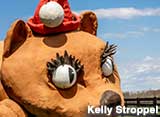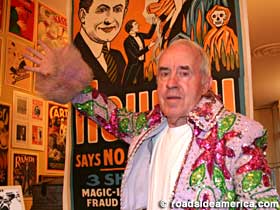
Museum volunteer Doug Collins dons a rare magician outfit.
American Museum of Magic
Marshall, Michigan
Attractions spawned from the obsession of one man (or woman) often do not survive their creators. The Wheels Museum, the Cypress Knee Museum, the Tower of Pallets -- all disappeared soon after their founders exited stage left, lingering only in memory ... primarily the memory of people like us.
That's why it's refreshing to see the American Museum of Magic perform its escape trick every day it manages to open to the public.
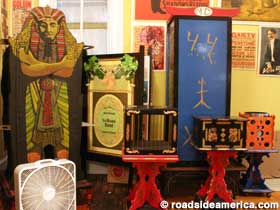
The American Museum of Magic was the progeny of Bob Lund, who began collecting magicians' artifacts in the mid-1930s and didn't stop until he died in 1995. Lund took pride in acquiring not only the props and posters of well-known magicians -- Blackstone, Dunninger, Houdini -- but of thousands of obscure, small-town conjurers as well. He went without a car and ate peanut butter sandwiches for years just so that he could buy more stuff. Had he lived, eBay would have killed him.
In mid-1970s Bob's wife Elaine told him, "Either stop collecting or move to a bigger place." Bob naturally chose Option 2. He and Elaine moved to Marshall, bought and renovated an ancient, three-story building in the historic district -- and the town's old library as well -- and turned them into the world's largest privately owned and publicly displayed collection of magic paraphernalia.
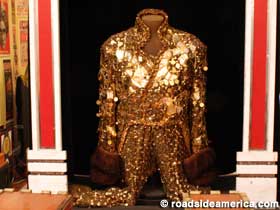
Elaine kept the place open after Bob died, but by then she was old, too, and the collection was getting disorganized. Happily, more people are obsessed with magic than, say, with cypress knees, and funds were raised. In 2005 a board of directors stepped in and began restoring the American Museum of Magic to its former glory.
On a recent visit we found the main floor of the museum to be in fine shape, with its 140-year-old woodwork and display cases gleaming. Doug and Betty Collins, two of the museum's staff of volunteers, showed us around.
The Lunds, despite their love of forgotten magicians, were sharp enough to put their superstar artifacts up front, to draw in people like us. Thus the first thing that you'll see when you enter is the custom-made milk can into which Harry Houdini would crawl -- handcuffed -- and then be thrown into the Detroit River. Next to the door is the box for Harry Blackstone's "Jam Illusion," in which two beautiful ladies were apparently crushed, but emerged unharmed. It now holds a TV for showing videos.
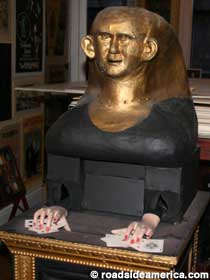
Sphinx card trick.
Doug Collins, who before he worked here spent 30 years raising 18,000 doves that he sold to magicians, walks us over to the cash register. He shows us a wall-sized poster for The Amazing Randi and recalls that Bob Lund offered visitors a million dollars if they could find Blackstone's name hidden in it. Thankfully for the finances of the American Museum of Magic, no one figured out the trick.
Obscure artifacts are everywhere here. The costume of Milky the Clown shares floor space with the sequined suits of Senor Rey, "the Liberace of magic." There's a disturbingly realistic guillotine, a ventriloquist dummy double used by Jay Marshall in his comedy magic act, Harry Blackstone's levitating skull, and a scroll given to Jean-Eugene Robert-Houdin (Houdini's idol) by the French government, after he had used magic tricks to spook the leaders of Algeria into submission. (Perhaps our foreign policy could be expedited by a draft of quality magicians.) Gaudy, eye-catching placards and one-sheets -- for performers such as "The Mental Wizard Newnann" and "Murray the Australian Escapeologist" -- with images of skeletons, scantly-clad women, whispering red devils, and men in tuxedos -- fill the walls up to the lofty ceiling. The museum has 5,000 more that it doesn't have the space to display.
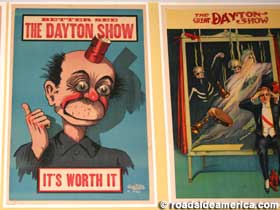
It is this wealth of extra, unexhibited stuff that gives this place such promise -- an estimated half-million pieces of magic memorabilia in boxes, upstairs, in the basement, and across the parking lot in the library. The museum has thousands of files on everyone from Doug Henning to Donna Delberts, "the world's only lady fire eater," who turned out to be an AWOL American GI and a man.
We take a peek upstairs and see more books, more weird props, and an apparently endless supply of posters and banners. There's a stack of original Mandrake comic strips, a Marshall Brodini magic set (one of only 500 ever made), and a display titled "Magic in Advertising," with a selection of trick premiums from boxes of Dunkin Donuts Cereal (glazed-style), a counter display of Monk Watson hawking Flare Hydraulic Brake Fluid, and promotional material for "Mr. MerryWeather -- The Ohio Bell Telewizard."
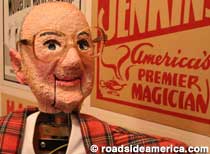
The American Museum of Magic is not really kid-friendly. The building is too quiet, too creaky; its displays are too unprotected and too handy for mischief. (We're thinking particularly of that guillotine.) As for adults, our only gripe is that this place could use some historical context. For all of its colorful ephemera, its tells nothing of the men behind the hypnotizing gaze, of how the vanishing birdcage evolved into the floating light bulb -- if indeed it did at all.
Or -- perhaps this museum doesn't need to. It is, after all, just up the road from Colon, Michigan, "The Magic Capital of the World," home of Abbott's Magic Company, the grave of Harry Blackstone Sr., and the annual Colon Magic Festival. The American Museum of Magic is really a destination for magic geeks who already know their stuff, where the faithful can come to gawk at their heroes -- just as we do -- and to ponder the spoor left by obscure progenitors of prestidigitation such as Ali Bongo, Mystic Craig, and Glenroy the Midget.




